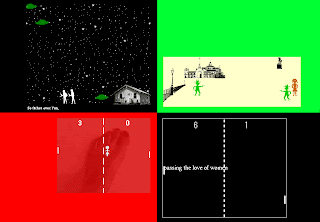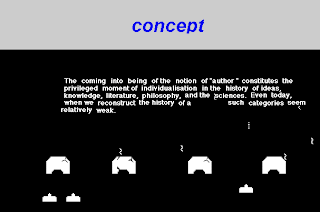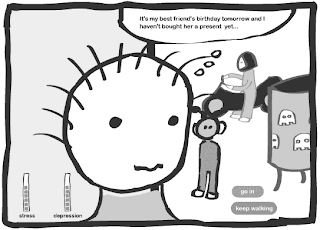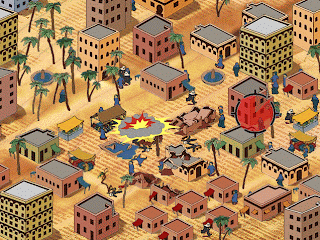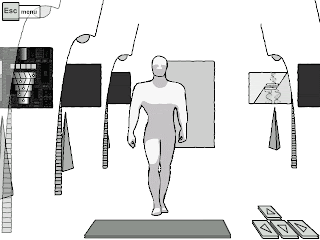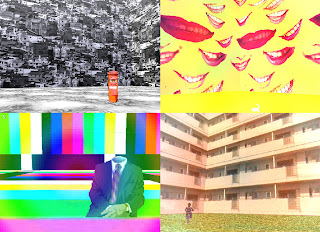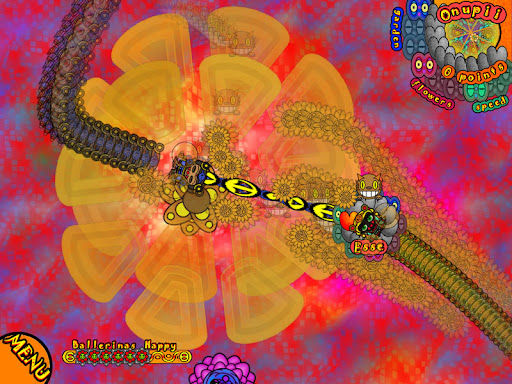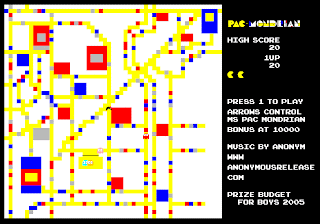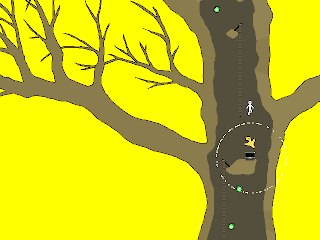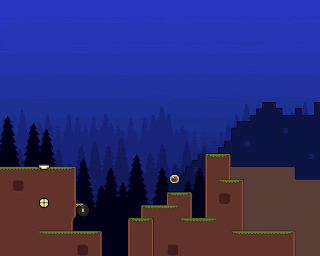Brainy Gamer on Sleep is Death
Audiosurf

Over the holidays I decided to grab another little indie title called Audiosurf. I couldn't resist the special they were having on Steam and decided to get it while the deal lasted. I had played the demo before and already knew I enjoyed the game, but having the full version's features made it that much better.
Audiosurf is an interesting hybrid of three different genres. Part music & rhythm game, part puzzle game, and part racing game, make for a very unique concept. Though it may sound like a bit of chaos when you think about putting those three play mechanics together, Audiosurf does manage to pull it off with surprising ease. The best part of this game, however, has got to be the personalization aspect of the play experience.
Audiosurf will use your computers music library to generate its tracks. We all have those songs that evoke specific memories or emotions, and when you combine your psychological associations with the visuals and mechanics of this game, the results are rather interesting. In faster paced songs, which are automatically more difficult, a high degree of concentration is required. This may in turn serve to override, or at least ammend, the mind's associated content with the music in question.
In the end, everyone will have a uniquely tailored experience with Audiosurf based on their music library. That is what makes this game immediately exciting, because of wanting to see how your favorite songs will "play." For those with sufficient levels of awareness, the mental effects of these experiences are also worth some consideration.
Art Games: News & New Releases
On account of a time crunch, and multiple posts waiting to be finished, this is going to be more of a news recap. I had intended to write some profound kind of commentary on the recent developments in art games, yet unfortunately that will have to wait.
Rest assured, some important games have come out in the genre this spring, while notable personages have tackled the subject in some form or other. An insightful critique of Rod Humble's new Stars Over Half Moon Bay was posted on Arthouse Games by Jason Rohrer. Meanwhile, Destructoid addresses art games in their podcast.
Additional comparisons were made between Portal and Rohrer's art game Passage, as well as Portal and Immortal Defense. Much of this has been mentioned in the Indiegames Blog feature Games As Art.
Which brings us to more notable art game released worth mentioning since my last big post. Though not exhaustive by any means, most of these have come out fairly recently.
Stars Over Half Moon Bay

The Graveyard

Questionaut
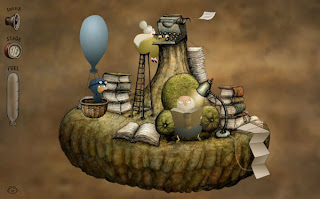
The Hangover

Hush

Gravitation

Knytt Nano
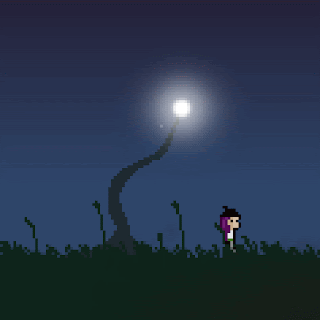
Passage

Randy Balma: Municipal Abortionist (coming soon)
Knytt Stories: The Minimal Symphony
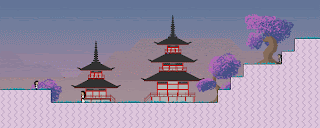
Over the last several months, Nifflas' new project has been getting a lot of attention. Not that anyone found this to be a surprise, as the independent gaming community is well aware of his reputation. His previous games, most notably Knytt and Within A Deep Forest, are renowned for their unique style and high quality.
Knytt Stories is the next addition to his portfolio, and we have already previewed and praised it at Indygamer. I personally put WADF at number one in my list of art games, and was happy to receive word from Nifflas in regard to that post. Since then, I was given the opportunity to preview the game itself, and I would like to share my thoughts on it with you.

The most prevalent design element which I see in all of Nifflas' games is minimalism. This does tend to come in varying degrees, but each title that he produces seems to follow the old adage of "less is more." Knytt Stories continues in this vein in all aspects as much as its predecessor, and that is in no small part a contributing factor to its success.
Knytt Art
The art style of Knytt Stories is certainly the first indicator of its minimalist approach. It is after all the first thing that the player sees. The environments in the game are always clean and effective. Clean because of some good spriting work, often foregoing dithering techniques in favor of simple geometric patterns. This is true of most foreground elements, while background elements will more often utilize a monochromatic pallet.
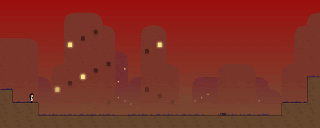
The backgrounds themselves range from either flat colored monochrome scenes, or more subdued and ethereally soft gradations. In all cases, the graphical elements blend together and create a strong interactive composition.
What is also interesting to note is how much attention was paid to lighting in the construction of the environments. Areas which in reality would have limited natural light tend to exhibit more contrast in their color palette. Indoor areas are a good example of this, with the foreground and background colors being further apart in tonal value. On the other hand, outdoor scenes with unobstructed sky share similar colors and have a much softer appearance, almost as if some natural elements like sunlight or fog were washing over the colors to give them such a quality.
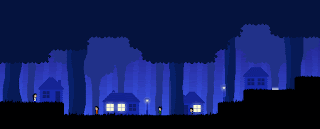
In essence, the artwork of Knytt Stories has impressed me even more than that of its predecessor. The simplicity and clean appearance of this game creates a powerful visual composition that is a delight for my eyes. It gradually undulates between gentle and strong colors that lend it just enough of the appropriate emotional quality in each scene. Yet there is never so much going on at once that it becomes occluded.
There is one danger that I have come upon in the game, which is a direct result of such beautifully crafted artwork. Many times as I ventured into an unexplored area I would be so taken by its new visual attributes that I just got lost in it and forgot where I was going. This is part of Knytt Stories' charm for me as an artist. I suppose many gamers won't have such a reaction to it, but some of you may. And allowing yourself to experience the game's art in this way can only enhance your overall enjoyment of it.
Knytt Sounds
The auditory stimulus of Knytt Stories is further proof of its minimalist design ethic. Naturally, all sound effects and music are in the style of electronica which Nifflas is already known for. I would say that much of the music is ambient, with a few exceptions in some areas which are distinctly different in visual style from the rest of the environments in the game.

When the player transitions from the less unconventional areas, if there is such a thing in Knytt Stories, to something like a snowy mountain top or a lava cavern, the music picks up in accordance with this change. Still electronic, it does at times bring in a little flare of Jazz into the mix. In the end, it always comes back to a more minimal and ambient melody or instrumentation.
One of my favorite audible experiences in Knytt has to be the occasional absence of all background music. A few areas will exhibit this, in which case the only sounds left are the pitter-patter of your Knytt's little feet. This, I have to admit, is quite adorable. Like a little church mouse, the Knytt scurries and pounces across the screen.
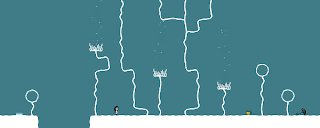
The reason for why this in particular has such a strong effect is because of that very absence of sound. When you remove elements from a design, whatever elements that are left gain emphasis, and their effect is that much stronger. This remains true throughout the game, as areas where there is little sound serve as a counterpoint for the areas where music does begin to play. Just as Nifflas accomplished this visually, so too the sounds of Knytt undulate in their intensity as you move through the game world. Ultimately, the auditory experience of this game is thoroughly enjoyable, no matter at which point in it's flow you may find yourself. And again there were times where I simply had to stop and listen to the music for a little while on account of its sheer artistry.
Knytt Play
The foundation for gameplay mechanics in Knytt Stories naturally stems from the preceding game, Knytt. At first glance, it behaves much like most platformers. There's running, there's jumping, and there's gravity to make it all work, etc. The primary difference between Knytt's gameplay and that of most of the genre is the ability to climb walls. This sounds very simple, but as I have said already, this is a game of effective simplicity.
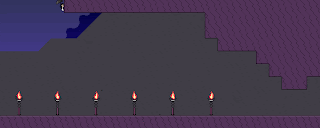
This one seemingly minor addition to your available actions changes the way you play the entire game. Unlike a typical platformer, Knytt has you spending about as much time climbing walls and jumping off of them as running on the ground and jumping onto platforms. As such, the games design takes off in this direction with facilitating exploration on both axes. Granted, this is not a novel invention, but it is done in a unique way, because I cannot think of any other 2d platformers which make climbing walls such an integral part of the game (though there may be a few I'm simply not familiar with).
Knytt Stories takes this mechanic a little further by limiting your abilities to perform these actions initially. You start with just being able to walk and jump a little, and you must get powerups that will allow you to run, jump higher, and climb walls. Further additions to your repertoire of skills not present in the original Knytt include a double jump, an umbrella to slow your fall, and an eventual "holographic decoy" generator.

This set of abilities is also not a new invention, but they do complement the traditional gameplay of Knytt wonderfully. Once you obtain these abilities, new dimensions of gameplay become available which you must utilize to explore the game world. As expected, all game mechanics are highly polished and never feel out of place. I think it's easy to take for granted the simplicity of the actions you take in such a game, yet it should be noted that it is because they work so well and are so solid that we do not often notice them.
Knytt Close
Each of the artistic parts of Knytt Stories is certainly admirable in its own right. A screenshot of the game's art is appealing enough to me to hang on my wall at ten times its original size. Its music I will undoubtedly be listening to for months to come, and the gameplay itself is good enough to stand on its own.

However, that is not what games are about. Games are about the totality of all these elements which then culminate in the players experience. It is unfortunate that there are different approaches to experience which then result in the experience being more or less amicable, but such is the nature of things. I would like to propose that there is probably a better way to experience Knytt Stories. It's simple and perhaps an obvious way, but it has the potential of enhancing the game.
It is recommended that the game be played with the best possible audio equipment, and the volume turned up to a clear and audible, but comfortable level. Good quality headphones serve this purpose well. In addition, it has to be played fullscreen, of course. A bigger screen is probably better. Finally, it is important to come to the game with an open mind. To elaborate, if you've been playing WoW and Halo for months, you will probably not enjoy Knytt Stories as much.
The fewer preconceptions you can bring with you the better. Not because your expectations will not be fulfilled, but because this game is a different experience than much of your standard gaming fare. Come to Knytt Stories relaxed. Come to it as you would come to an old friend you have not seen for years, and it will treat you well. If you can manage to do all this, it is unlikely that you will be disappointed.
Art Games: Controversy
Since posting the Art Games: Best Indy Titles list I have been the subject of much criticism and controversy. One may think that this is better than no response, yet I have to wonder. Still, it is an approximate 1% out of everyone who has looked at the list that took the time to respond. Not sure whether this means that the other 99% liked it or not. I suppose there's no way to tell.
Since I clearly missed some games, those who were not included would naturally be unhappy. On the other hand, those that were included didn't seem to have any objections to the list. More positive receptions came from the creators Raph Koster, Tale of Tales, and Xii Games.
I am debating a revision to the list, with additional games that have been suggested by some of the commenters. I wonder if time will permit more work on this, since the first list did take some time to compile and rate. I'll see what I can do.
I normally would say something about "I encourage you to comment," but I'm a little hesitant to invite any further wrath from gods of gaming. In the end, it's another testament to the old adage that "you can't please everybody."
Art Games: Best Indy Titles
When I think of art that has influenced me most, it is generally work done by individuals. I can't recall the last time a corporation created a brilliant painting. I find that this also tends to be true in the emerging area of art games. Individuals are not generally driven to create purely for profit, and have more leeway to experiment and create according to their own artistic vision.
I thought it was time to compile a "best of" list for art games, because there has only been one other such list that I recall online. I'm sure someone will correct me on that point if there has been in fact another well drafted list somewhere out there. The first list can be found in an article on Artifical.dk, titled Art Games - Artificial's List [...]. I thought that Kristine Ploug had done a great job with her articles, though the list did leave out a number of titles which I thought should have been included.
This was also about two years ago, and since then more art games have surfaced. In the meantime, some of the games are no longer accessible, which is the unfortunate reason for why I could not include or rate them here. The creations of Geoffrey Thomas (i.e. Left to My Own Devices) cannot be played anymore. Torrent Raiders is still available for download, but I had the game crash on me every time, which renders it unplayable. Last but not least, a collection of mods of games and engines used as art is still up at Selectparks.net, though most links are now dead.
As such, I am providing this list of 27 titles. Some of these are older, while others are quite new. Each game was rated based on mechanics, visual style, and auditory stimulus which then determined it's place in the list. Keep in mind that I used my background as an artist to judge the merit of each category. This means that each games place in the list is not based on whether it was simply "good" or "pretty." It's not a perfect system, but it should hopefully serve as a guide to the indy art game scene.
So, without further ado, I present to you the Best Indy Art Games...
27. The Intruder
Good concept, nice use of old school gameplay, yet seems to be exhibiting technical issues (possibly a result of Shockwave player version discrepancy).
26. Triggerhappy
An interesting twist on a classic, Triggerhappy provides a few minutes of entertainment but is clearly basic. Still, it has something to say about concepts and genres, which is at the heart of the art game phenomenon.
25. The Nerve Game
While it does provides some relevant commentary on the modern lifestyle, The Nerve Game would benefit from a more unique overall design.
24. Copic Fighter (Reviewed by Chris of The Artful Gamer)
Currently a work-in-progress demo of a standard vertical scrolling shooter. Features an interesting twist of using a [Copic] marker instead of a "ship", and ink instead of "bullets". Will benefit from additional levels, and more fine-tuning and expansion of the art library.
23. September 12
Direct and to the point. September 12 is a statement about current political events with an obvious result: there are no winners.
22. Raspberry
This is a good experiment in terms of mechanics, yet it can feel too repetitive in the long run. Although this was the intention, with basis in musical composition, Raspberry's execution could benefit from further refinement.
21. Average Shoveler
Well made visually, Average Shoveler takes its inspiration from eighties and nineties adventure games. It also serves as commentary on modern media, casting an unfavorable light on its prevalence in our culture.
20. Anna
Minimal and atmospheric, the artistic vision of Anna comes through very clearly. Though perhaps not universally accessible due the puzzles in the game, it becomes more engaging with perseverance.
19. SOUP ver. 09
Surreal and experiential, yet with a repetition that lends it a comforting familiarity. Small graphical improvements and added length would help SOUP to become even more effective, but this remains a title that Warhol would be proud of.
18. Blumenmacht
Very original, and enjoyable to play. It's non-violent nature creates an amicable experience, but the visuals in Blumenmacht can be at times overpowering. Keep in mind that it may take more than one time of going through the tutorial to fully grasp the unconventional mechanics. Once you have a handle on them, gameplay makes much more sense and, in turn, becomes easier.
17. Pac-Mondrian
Few other games have taken such great icons of art and gaming and fused them to create something new with. The mechanics are fairly solid, though not all levels seem to be functional any longer.
16. Orisinal
With so many minigames, Orisinal is a veritable cornucopia of experiences. Yet they all share the same high level of polish, with beautiful graphics and music. Gameplay remains quite basic in each game, only holding your interest for a limited time. As a hole, however, there is enough to keep you busy for quite some time.
15. Facade
An intruiging experiment, and proportionally rewarding to the player's engagement. Though not a perfect system, Facade is still unique in the gaming industry as a whole. With a little more work, adding accuracy to this technology, it could very well revolutionize in game interaction.
14. Seiklus
Clean and effective, the visual elements of Seiklus provide an inspiring experience. Room for improvement lies in it's control mechanism, yet that is a small issue and should not detract from the game's enjoyment.
13. Andean Bird
Quite unlike anything else out there, Andean Bird offers a leisurely glide across the landscape to the accompaniment of beautiful music. It does manage to instill some of the qualities of flight, yet that same endeavor is hampered by its lack of fullscreen capability.
12. Rainy Day
Yet another experiment which succeeds in bringing a new mechanic to gaming, and manages to be quite enjoyable. Rainy Day's nineteenth century style is a welcome choice, and the only criticism to be found is its brevity.
11. Evolites
Attractive in it's own right, this evolution simulation can be a soothing exhibition of “artificial” selection, yet it also allows the player to engage and dictate the outcome of the process.
10. Boidtrancer
Its gameplay may offer much in terms of familiarity, yet the visual presentation more than makes up for that. Uniquely abstracted, and audibly stimulating. Boidtrancer renders minimal imagery to the beat of some alluring Japanese techno.
9. What Linus Bruckman Sees When His Eyes Are Closed
Comic and enigmatic, surreal and mystical, this game maintains its split-personality throughout. One of the most original adventure games to date, yet it may also discourage some casual players with the difficulty of its puzzles. Nvertheless, such are the conventions of the genre.
8. Cultivation
Fun to play and always in flux, Cultivation is a statement about conflict and violence in an unusual metaphor. This wonderfully original concept will have you actually spending a good bit of time with the game, allowing for something new with each playing session.
7. Samorost 1 & 2
The beautiful photo-manipulated backgrounds of the Samorost games serve to create every stage of this puzzle adventure in a style reminiscent of classic fantasy illustration. At times challenging, both iterations offer great atmosphere, and result in what feels like a very unique and interactive Rube Goldberg machine.
6. The Marriage
Low-fi minimalism at its best. The Marriage is a human relationship articulated by little more than game mechanics itself, and that's a rarity in this medium. This title is particularly relevant to those who are or have been married, and has even been utilized in marriage counseling sessions. Playing this more than once is highly recommended.
5. Sub Atomic, The Life In Matter, Valence (and others by Iteration Games)
All of Iteration Games' offerings share a similar artistic style, and all are similarly well done. Gameplay is always solid, taking cues from familiar mechanics and putting a unique spin on them. The biggest common denominator in these games is the strong techno-style art and sound which complement each title, and make for an excitingly ephemeral encounter.
4. Noiz2sa
Out of all the abstract shooters to date, Noiz2sa still feels the most artistic. It's foundation is purely low-fi, with squares and rectangles as the only shapes in the game. Their frequency and configuration, however, bring a more current flare to the experience that accrues into unique particle effects and some serious bullet hell patterns. This is a marriage of right angles and techno with a pinch of adrenaline for good measure.
3. Flow
Of course who could forget Flow, Jenova Chen's brainchild. The execution is arguably top notch, and it is a very successful experiement in game . . .well, flow! Beyond this, it's minimal visuals and soothing ambient sound gives the player a chance to relax. A testament to post-modernism, Flow is as a Lucio Fontana painting in motion.
2. The Endless Forest
If WoW and Seaman had an illicit affair, their offspring would be The Endless Forest. It resolves one of the biggest problems of an MMO, being the useless and idle talk of the people in it. Not being a able to speak is a boon to online gaming. At last, it's about the experience of content rather than a social outlet. Be prepared to immerse yourself in a world devoid of quests, raids, and the idiocy of the chat window. Oh, and make sure your volume's turned up.
1. Within a Deep Forest (and the games of Nifflas)
So here it is, in first place. Who knew it was going to make it to the top? Frankly, there is no reason for Within a Deep Forest not to be up here (though some have claimed it to be overrated). In light off its excellent quality in all attributes, this games is probably the best example of a game as art. Its simple yet challenging, not to mention addictive, gameplay will keep you in there. Its strikingly beautiful artwork, though subtle and retro, will have you wanting to see more. And the wonderfully composed music may just have you listening to it months after you complete the game. All-in-all, these elements which have been crafted with such care come together to bring you a feast for the senses.
Such is the trademark we have come to recognize in all of Nifflas' creations. First place goes to his endeavors as a whole, which have culminated in this game. I suspect that his current project, Knytt Stories, will climb towards the top of another such list in the future.
Art Games: At The Museum

Some critics may be dismissing the idea of games as art all too quickly, yet these are not the people who's authority carries much weight on the subject. If you want to know whether games are art, would it not make sense to bring that question before the art world?
As the blogosphere mulls over the finer points of this discussion, artists at established institutions such as Parsons The New School for Design in New York, the Academy of Art University in San Francisco, and Otis College of Art and Design in L.A. have already moved on to create works in this medium. In conjunction with EA, a series of shows at each of these schools named The Sims: In the Hands of Artists has brought forth results that the art community has already accepted. Works from students at Parsons were exhibited at the Chelsea Art Museum in New York (briefly mentioned on Kotaku), while the other collections found their homes in the AAU 79 Gallery and Otis' Ben Maltz Gallery respectively.
In addition to such widespread acceptance, the success of this endeavor was also touted in a recent ARTNews article titled Messaging is the Medium. The Author, David Ng is a contributing writer for The Believer and The Village Voice. He talks in his article about the artists' using The Sims as a platform for mods and machinima. Screenshots featured are from The Sims 2: The Ten Plagues Expansion, a mod sporting biblical plagues such as diseased livestock, water transformed into blood (like the image above), as well as locusts, hail and fire.
Now, I don't know about you, but I'm more inclined to put stock in the actions of three prominent art schools and major galleries, not to mention the artists themselves, over the words of one (or more) jaded media critics. The revolution began a long time ago. The fact that the rest of the world still hasn't caught on to this reality is regrettable, but somewhat inconsequential at this point.
Art Games: The Debate's Back!

Just as I was getting warmed up to fire away some additional posts on the art games discussion, fellow IndyGamer writer Shih Tzu beat me to the punch on Wednesday. Apparently, some time ago (as in 2005), Ebert caused quite a stir in this area. What brought it all up again was Ebert's reply to Cliver Barker's commentary at GamesIndustry.biz.
Right away, game enthusiasts from all over the world saw holes in Eberts response. As Shih Tzu put it, "I expected gamers would react to his latest uninformed salvo, but what I didn't expect is the responses (the printed ones, at least) to be by and large so lucid and articulate." Jason Rohrer then ran with this, posting for us at IndyGamer, as well as on his Arthouse Games blog, a mock-dialogue addressing the Ebert vs. Barker debate.
Having written on the subject previously, it would be simply uncouth of me not to provide my commentary on the issue in light of these events. Everyone has brought up very good points in their posts to be sure, and it makes me happy to be among such intelligent company (albeit virtually). Nevertheless, some problems with the discussion that I see lying at the core have not been touched on yet, and I would like to address those.
One of the first things Ebert writes in response to Baker is that "anything can be art. Even a can of Campbell's soup. What I should have said is that games could not be high art, as I understand it." This really means that Ebert believes games can be art. Which is really the end of that debate, while also giving rise to the debate of whether games can be high art. I suppose that at first glance that doesn't change much, but let us take a closer look.
I have mentioned to a few people that I have grown tired of the same old question being asked and rehashed. It's the question of whether games are art. To me the answer is an obvious yes. And though it all lacks development, my position is that not only can all things be art but that all things are indeed art. The difference lies purely in how something is perceived. Did not Duchamp demonstrate this ninety years ago?
Based on this, the question of whether something is or is not art remains largely redundant. Yet when you ask whether something is high art, a different set of baggage is dragged upon the scene. As noted in the Wikipedia article just linked, the term "high art" has been most criticized for its association with elitism. At it's more basic level, high art vs. low brow art is once again merely a difference of perception. The existence of creativity cannot be simply measured by social status, or even the status of civilization.
Simply because a small percentage of people who live well and have money decide to call themselves and what is theirs "high," relegating the status of "low" to all that is so to speak beneath them does not make it so. Consequently, if high art is only that which is accepted by this select group of individuals, then I should hope for all that I hold dear not to fall into such a category. This includes games. I would be more than happy to let Mr. Ebert have his high art such as he likes it, so that he may enjoy it in his station.
Seeing as how I find the distinction of high art to be less than based in truth, I would just as soon eliminate it all together. Reverting to my initial assessment of what art is, I see no use for creating a class system for said art. The resulting assessment would be that whether games are high art irrelevant, just as the label of high art itself is irrelevant.
With that being said, it appears to me that Ebert has in fact admitted to games being art. He may be unclear as to what kind of art they are, and whether it befits someone of his status, yet they are art nonetheless.



